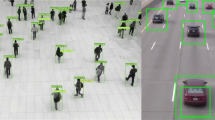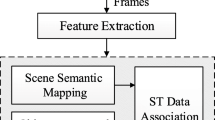Abstract
Human-robot collaboration (HRC) based on speed and separation monitoring should consider the difference of risk factors in the scene; otherwise, the sudden invasion of non-operators or routine operation of the operator may stop the robot system. In this paper, we propose a sensing network based on the fusion of multi-information to obtain scene semantic information and employ it to realize risk assessment. However, due to the influence of light on the image information sensed by RGB cameras, it is not easy to obtain accurate scene semantic information. We apply a depth camera and a thermal imager to obtain depth and infrared information to enhance the RGB images. We build a risk information database and use it to quantify the obtained scene semantic information into risk factors. The dynamic change of risk factors judges whether the distance between humans and robots is safe. The experimental results verify that the algorithm of intelligent human-robot monitoring can realize the analysis of dangerous situations and control the robot system, thereby reducing the number of false shutdowns and improving safety.
Similar content being viewed by others
References
Ajoudani, A., Zanchettin, A.M., Ivaldi, S., Albu-Schäffer, A., Kosuge, K., Khatib, O.: Progress and prospects of the human---robot collaboration. Auton. Robot. 42(5), 957–975 (2018)
Bdiwi, M.: Integrated sensors system for human safety during cooperating with industrial robots for handing-over and assembling tasks - ScienceDirect. Proc. CIRP. 23, 65–70 (2014)
Matthias, B., Reisinger, T.: Example Application of ISO/TS 15066 to a Collaborative Assembly Scenario. In: Isr: International Symposium on Robotics (2016)
Marvel, J.A.: Performance metrics of speed and separation monitoring in shared workspaces. IEEE Trans. Autom. Sci. Eng. 10(2), 405–414 (2013)
Zanchettin, A.M., Ceriani, N.M., Rocco, P., Ding, H., Matthias, B.: Safety in human-robot collaborative manufacturing environments: metrics and control. IEEE Trans. Autom. Sci. Eng. 13(2), 882–893 (2015)
Shin, H., K. Seo, and S. Rhim. Allowable Maximum Safe Velocity Control Based on Human-Robot Distance for Collaborative Robot. 2018
Byner, C., Matthias, B., Ding, H.: Dynamic speed and separation monitoring for collaborative robot applications - Concepts and performance. Robot. Comput. Integr. Manuf. 58(AUG.), 239–252 (2019)
Cai, K., Wang, C., Song, S., Chen, H., Meng, M.Q.H.: Risk-aware path planning under uncertainty in dynamic environments. J. Intell. Robot. Syst. 101(3), 47 (2021)
Tarbouriech, S., Suleiman, W.: Bi-objective motion planning approach for safe motions: application to a collaborative robot. J. Intell. Robot. Syst. 99(1), 45–63 (2020)
Chen, J.H., Song, K.T.: Collision-free motion planning for human-robot collaborative safety under Cartesian constraint. In: 2018 IEEE international conference on robotics and automation (ICRA) (2018)
Wei, Q., Zha, D., Jie, Z.: An effective approach for causal variables analysis in diesel engine production by using mutual information and network deconvolution. J. Intell. Manuf. 9, 1–11 (2018)
Marvel, J.A., Falco, J., Marstio, I.: Characterizing task-based human–robot collaboration safety in manufacturing. IEEE Trans. Syst. Man Cybern. Syst. 45(2), 260–275 (2015)
Lucci, N., Lacevic, B., Zanchettin, A.M., Rocco, P.: Combining speed and separation monitoring with power and force limiting for safe collaborative robotics applications. IEEE Robot. Autom. Lett. 5(4), 6121–6128 (2020)
Kim, E., Kirschner, R., Yamada, Y., Okamoto, S.: Estimating probability of human hand intrusion for speed and separation monitoring using interference theory. Robot. Comput. Integr. Manuf. 61, 101819.1–101819.7 (2020)
Kumar, S., Arora, S., Sahin, F.: Speed and Separation Monitoring using on-robot Time--of--Flight laser--ranging sensor arrays. In: 2019 IEEE 15th International Conference on Automation Science and Engineering (CASE) (2019)
Mazhar, O., Navarro, B., Ramdani, S., Passama, R., Cherubini, A.: A real-time human-robot interaction framework with robust background invariant hand gesture detection. Robot. Comput. Integr. Manuf. 60, 34–48 (2019)
Aliev, K., Antonelli, D.: Proposal of a monitoring system for collaborative robots to predict outages and to assess reliability factors exploiting machine learning. Appl. Sci. 11(4), 1621 (2021)
Wu, Q., Ding, K., Huang, B.: Approach for fault prognosis using recurrent neural network. J. Intell. Manuf. 31(7), 1621–1633 (2020)
Sun, Y., Zuo, W., Liu, M.: RTFNet: RGB-thermal fusion network for semantic segmentation of urban scenes. IEEE Robot. Autom. Lett. 4(3), 2576–2583 (2019)
Qi, C.R., et al.: PointNet: deep learning on point sets for 3D classification and segmentation. In: 2017 IEEE conference on computer vision and pattern recognition (CVPR) (2017)
Lecun, Y., Bengio, Y., Hinton, G.: Deep learning. Nature. 521(7553), 436–444 (2015)
Haddadin, S., Luca, A., Albu-Schäffer, A.: Robot collisions: a survey on detection, isolation, and identification. IEEE Trans. Robot. 33(6), 1292–1312 (2017)
Albini, A., Cannata, G.: Pressure distribution classification and segmentation of human hands in contact with the robot body. Int. J. Robot. Res. 39(6), 668–687 (2020)
ArkinJacob, et al.: Multimodal estimation and communication of latent semantic knowledge for robust execution of robot instructions. Int. J. Robot. Res. 39(10–11), 1279–1304 (2020)
Zhou, T., Wachs, J.P.: Spiking neural networks for early prediction in human–robot collaboration. Int. J. Robot. Res. 38(14), 1619–1643 (2019)
Bouvrie, J.: Notes on Convolutional Neural Networks. neural nets (2006)
He, K., et al.: Mask R-CNN. In: 2017 IEEE International Conference on Computer Vision (ICCV) (2017)
Ren, S., He, K., Girshick, R., Sun, J.: Faster R-CNN: towards real-time object detection with region proposal networks. IEEE Trans. Pattern Anal. Mach. Intell. 39(6), 1137–1149 (2017)
The American Society of Safety Engineers: ANSI Z10, Occupational health and safety management systems. The American National Standards Institute (2012)
Acknowledgement
Research was supported by the National Key Research and Development Program of China under Grant 2019YFB1310200.
Code Availability
All data and materials as well as software application or custom code support our published claims and comply with field standards.
Funding
Partial financial support was received from the National Key Research and Development Program of China under Grant 2019YFB1310200.
Author information
Authors and Affiliations
Contributions
All authors contributed to the study conception and design. Material preparation, data collection and analysis were performed by Botao Yang, Shuxin Xie, Guodong Chen, Zihao Ding, and Zhenhua Wang. The first draft of the manuscript was written by Botao Yang and all authors commented on previous versions of the manuscript. All authors read and approved the final manuscript. Botao Yang and Shuxin Xie are contributes equally to this work.
Corresponding author
Ethics declarations
Conflict of Interest
The authors declare that they have no known competing financial interests or personal relationships that could have appeared to influence the work reported in this paper.
Ethics Approval
Approval was obtained from the ethics committee of Soochow University.
Consent to Participate
Informed consent was obtained from all individual participants included in the study.
Consent for Publication
The participant has consented to the submission of the research manuscript to the journ.
Additional information
Publisher’s Note
Springer Nature remains neutral with regard to jurisdictional claims in published maps and institutional affiliations.
Rights and permissions
Springer Nature or its licensor holds exclusive rights to this article under a publishing agreement with the author(s) or other rightsholder(s); author self-archiving of the accepted manuscript version of this article is solely governed by the terms of such publishing agreement and applicable law.
About this article
Cite this article
Yang, B., Xie, S., Chen, G. et al. Dynamic Speed and Separation Monitoring Based on Scene Semantic Information. J Intell Robot Syst 106, 35 (2022). https://doi.org/10.1007/s10846-022-01607-2
Received:
Accepted:
Published:
DOI: https://doi.org/10.1007/s10846-022-01607-2




